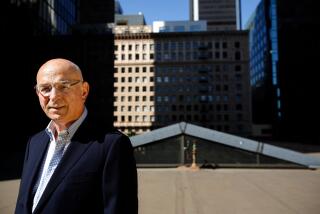‘Julius Shulman Los Angeles’ has some new angles
This week, Rizzoli publishes “Julius Shulman Los Angeles,” a new book featuring a variety of shots taken in Southern California by the famed architectural photographer, who died two years ago at age 98. Times architecture critic Christopher Hawthorne recently caught up with one of the book’s co-authors, Sam Lubell, who is also West Coast editor of the Architect’s Newspaper. What follows is a condensed version of their email exchange.
Does the world need another book on Julius Shulman?
That’s what I was wondering when we started this book. But we discovered that the world had a largely mistaken impression about Shulman’s work. Less than a quarter of his pictures captured the work of the big names — Neutra, Eames, Wright. The majority of his career was everything else: his shots for large firms, for obscure magazines, for advertising agencies, for corporations and for hundreds of other clients.
How did you and your co-author, Douglas Woods, decide to focus on Shulman’s photographs of Los Angeles?
We started out doing a book about Shulman’s interiors, but we were worried it would start to look like all the other Shulman books. We were given a great tip from Anne Blecksmith at the Getty Research Institute [which holds the Shulman archive]: Check out the higher numbered boxes in the archives. The ones that have been barely looked at, let alone published. Most of those pictures were of the Los Angeles region. Shulman of course photographed everywhere, but this was his home, and L.A. was always his passion and his laboratory. It was here that his collection of pictures truly told a story about a place.
Your book’s subtitle is “The Birth of a Modern Metropolis.” In what ways did Shulman capture, or even accelerate, L.A.’s emergence as a global city?
I don’t want to overstate Julius’ influence, because of course the city would have developed with or without him. But what he did was shape outsiders’ conception of Los Angeles. People saw a place where you could live outside all year long. Where modernity was embraced and the old norms appeared not to apply. Of course there were stretches of L.A. that were ugly and boring, but through Julius’ lens (and through careful cropping and framing) everything looked beautiful, new and exciting.
What’s your favorite image in the book?
A photograph taken from the roof of the El Cortez hotel in San Diego. It’s of a man looking down, captivated by the city beneath him. I see that man looking down as Julius: the awestruck observer of the excitement going on around him. You can sense how taken Julius was by such places. In the picture you see some of San Diego’s major landmarks. But more than the individual elements and the now-wonderful historical information, it’s the sense of magic and possibility and the almost dreamlike quality of it all that makes this picture special. It’s an architectural picture, but it’s telling a story. That’s what Julius’ most successful pictures all did. At heart he was a storyteller more than anything.
I’ll tell you what my favorite image is: a color shot of the Panorama Market, Reseda, 1956. Stacked Cheerio and soda cracker boxes. Seems to anticipate both Warhol and Andreas Gursky.
I love that shot too. It really encapsulates that time period. Just the fonts and the labels and the colors and the lighting and even the prices. It all just oozes 1950s L.A. To me, it’s more the story of a time than of any particular place. He doesn’t even have to show any architecture or people — his supposed specialties — to tell the story. And even though it’s a grocery store he incorporates his keen eye for composition: the fading diagonals of the fluorescent lights; the repeating aisles; the stacks of boxes and cans. It’s classic Shulman even without much architecture.
christopher.hawthorne@latimes.com
More to Read
Sign up for our Book Club newsletter
Get the latest news, events and more from the Los Angeles Times Book Club, and help us get L.A. reading and talking.
You may occasionally receive promotional content from the Los Angeles Times.







